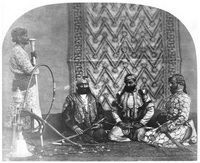
Khatana
Actor
Gurjar or Gujjar (also known as Gojar and Goojar) is an ethnic agricultural and pastoral community of India, Pakistan, and Afghanistan. They were known as Gurjaras during the medieval times, a name which is believed to have been an ethnonym in the beginning as well as a demonym later on. Although traditionally they have been involved in agriculture (most famously, dairy and livestock farming), Gurjars are a large heterogeneous group that is internally differentiated in terms of culture, religion, occupation, and socio-economic status. The historical role of Gurjars has been quite diverse in society, at one end they are founders of several kingdoms, districts, cities, towns, and villages, and at the other end, they are also nomads with no land of their own. The pivotal point in the history of Gurjar identity is often traced back to the emergence of a Gurjara kingdom in present-day Rajasthan during medieval times (around 570 CE). It is believed that the Gurjars migrated to different parts of the Indian Subcontinent from the Gurjara kingdom. Previously, it was believed that the Gurjars did an earlier migration from Central Asia as well, however, that view is generally considered to be speculative. Historical references speak of Gurjara warriors and commoners in North India in the 7th century CE, and mention several Gurjara kingdoms and dynasties. The Gurjaras started fading way from the forefront of history after 10th century CE. Thereafter, several Gurjar chieftains and upstart warriors are mentioned in history, who were rather petty rulers in contrast to their predecessors. The modern forms "Gurjar" and "Gujjar" were quite common during the Mughal era, and documents dating from the period mention Gurjars as a "turbulent" people. The Indian states of Gujarat and Rajasthan were known as Gurjaradesa and Gurjaratra for centuries prior to the arrival of the British power. The Gujrat and Gujranwala districts of Pakistani Punjab have also been associated with Gujjars from as early as the 8th century CE, when there existed a Gurjara kingdom in the same area. The Saharanpur district of Uttar Pradesh was also known as Gujarat previously, due to the presence of many Gujjar zamindars, or land holding farmer class, in the area. Gurjars are linguistically and religiously diverse. Although they are able to speak the language of the region and country where they live, Gurjars have their own language, known as Gujari. They variously follow Hinduism, Islam, and Sikhism. The Hindu Gurjars are mostly found in Indian states of Rajasthan, Haryana, Madhya Pradesh, Punjab Plains and Maharashtra, while the Muslim Gujjars are mostly found in Pakistan, Afghanistan and Indian Himalayan regions such as Jammu & Kashmir, Himachal Pradesh and Garhwal and Kumaon divisions of Uttarakhand. The Gurjars are classified as Other Backward Class (OBC) in some of India's States and UTs; in Jammu and Kashmir and some parts of Himachal Pradesh they are categorised as a Scheduled Tribe. Hindu Gurjars were assimilated into various varnas in the medieval period.
Gurjar or Gujjar (also known as Gojar and Goojar) is an ethnic agricultural and pastoral community of India, Pakistan, and Afghanistan. They were known as Gurjaras during the medieval times, a name which is believed to have been an ethnonym in the beginning as well as a demonym later on. Although traditionally they have been involved in agriculture (most famously, dairy and livestock farming), Gurjars are a large heterogeneous group that is internally differentiated in terms of culture, religion, occupation, and socio-economic status. The historical role of Gurjars has been quite diverse in society, at one end they are founders of several kingdoms, districts, cities, towns, and villages, and at the other end, they are also nomads with no land of their own.
The pivotal point in the history of Gurjar identity is often traced back to the emergence of a Gurjara kingdom in present-day Rajasthan during medieval times (around 570 CE). It is believed that the Gurjars migrated to different parts of the Indian Subcontinent from the Gurjara kingdom. Previously, it was believed that the Gurjars did an earlier migration from Central Asia as well, however, that view is generally considered to be speculative. Historical references speak of Gurjara warriors and commoners in North India in the 7th century CE, and mention several Gurjara kingdoms and dynasties. The Gurjaras started fading way from the forefront of history after 10th century CE. Thereafter, several Gurjar chieftains and upstart warriors are mentioned in history, who were rather petty rulers in contrast to their predecessors. The modern forms "Gurjar" and "Gujjar" were quite common during the Mughal era, and documents dating from the period mention Gurjars as a "turbulent" people. The Indian states of Gujarat and Rajasthan were known as Gurjaradesa and Gurjaratra for centuries prior to the arrival of the British power. The Gujrat and Gujranwala districts of Pakistani Punjab have also been associated with Gujjars from as early as the 8th century CE, when there existed a Gurjara kingdom in the same area. The Saharanpur district of Uttar Pradesh was also known as Gujarat previously, due to the presence of many Gujjar zamindars, or land holding farmer class, in the area.
Gurjars are linguistically and religiously diverse. Although they are able to speak the language of the region and country where they live, Gurjars have their own language, known as Gujari. They variously follow Hinduism, Islam, and Sikhism. The Hindu Gurjars are mostly found in Indian states of Rajasthan, Haryana, Madhya Pradesh, Punjab Plains and Maharashtra, while the Muslim Gujjars are mostly found in Pakistan, Afghanistan and Indian Himalayan regions such as Jammu & Kashmir, Himachal Pradesh and Garhwal and Kumaon divisions of Uttarakhand.
The Gurjars are classified as Other Backward Class (OBC) in some of India's States and UTs; in Jammu and Kashmir and some parts of Himachal Pradesh they are categorised as a Scheduled Tribe. Hindu Gurjars were assimilated into various varnas in the medieval period.
Khatana Movies & TV Shows - Watch Online


